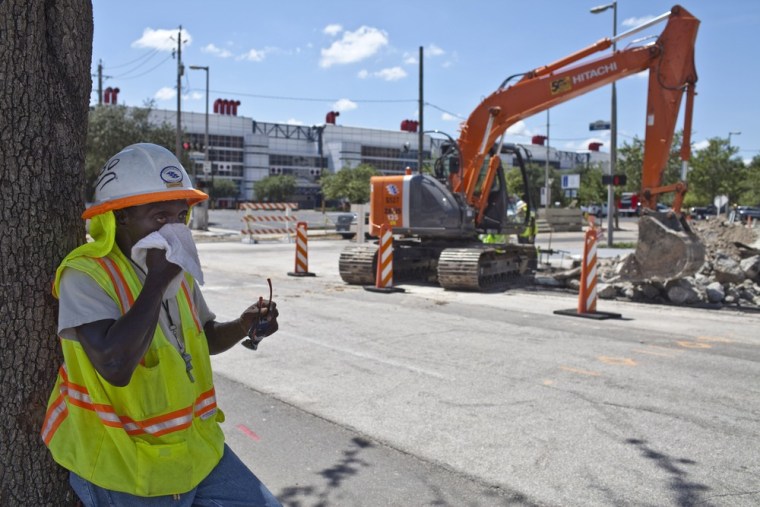Jose M. Perez, a laborer working in a big hole 70 feet down on the Queens side of the tunnels that will connect the Long Island Rail Road and Grand Central Terminal, is desperately waiting for the cool winter months.
“We laborers must deal with the heat 91 out of 365 days a year,” he said. “It’s grueling and insufferable for most of us. A lot of stagnant water, thousands of mosquitoes, at times concrete curing at 120 degrees and stale air with 100 percent humidity.”
With record-setting heat in New York and across the country this summer, many workers who don’t toil away in air-conditioned offices have found this one of the toughest summers to keep grinding away in.
The high temperatures have led to illnesses and some deaths, with government officials warning that employers and employees have to be diligent about beating the heat.
“July was hottest on record in most of the U.S., and it’s important for all employers and workers to be aware of this,” said David Michaels, assistant secretary of labor for the Occupational Safety and Health Administration, or OSHA. “The symptoms of heat are often not easily recognizable.”
To that end, the agency this year launched a campaign to help prevent the thousands of heat-related illnesses on the job annually.
“Every summer dozens of fatalities are associated with heat,” Michaels said. The campaign has a simple message: “Water. Rest. Shade. The work can’t get done without them.”
In 2009 there were 33 on-the-job deaths related to heat, with workers in agriculture, mining and construction most likely to be affected, according to the most recent OSHA data available.
The highest number of heat-related fatalities were in California, Florida and Texas, mainly because of the importance of agriculture and the likelihood of farm workers being exposed to heat. But Michaels said there are growing problems in states that aren’t used to such sustained high temperatures.
“One of factors of heat fatalities is acclimation,” he said. “Places where heat is not a normal condition are of great concern, including North Central states and New England.”
Here’s a look at the most grueling jobs of the hot summer months (the list includes data from OSHA and the Bureau of Labor Statistics from 2009, the most recent data available):
Roofers
Roofers had the highest rate of non-lethal injuries related to heat, at about six workers out of every 10,000 full-time employees in 2009.
“Roofing is a horrible job,” said Robinson. “You’re up on a roof with buckets of tar that have to be hot and runny or you can’t apply it, and there’s no shade.”
Baggage handler
Those folks who get your luggage to where it’s supposed to go when you travel also face ultra-hot work environments. The scheduled passenger air transport category, which includes mainly baggage handlers, had the second-highest rates of injury related to heat in 2009.
Foundry worker
Foundries can be extremely hot workplaces because heating of materials including metals. Even though the industry only employs about 10,000 workers, “We see fatalities every year,” said OSHA’s Michaels. Most of the jobs are in Wisconsin, Ohio and Indiana.
Road crew
Many municipalities try to conduct roadwork at night in the summer to help workers beat the heat, but the job is still considered a top concern by OSHA.
Farm workers
Agriculture has a high incidence of heat-related injuries, and farm workers in particular can be the most susceptible.
Last month, two California farm workers died during particularly hot days, and the state’s Division of Occupational Safety and Health is investigating the deaths and whether they were related to heat, said Dean Fryer, a spokesman for the agency, who said agriculture and construction have the most violations.
So what do you do if you think the heat is just unbearable and want to stop working?
“We can’t advise workers to stop working unless it’s a very serious hazard,” or poses “imminent danger,” Michaels said.
But he said workers who raise concerns about their health and safety are protected by OSHA laws and cannot be retaliated against.
If an employee sustain some sort of injury as a result of heat, they could be entitled to workers compensation, but the illness or injury has to be tied to the workplace or work activity, said Tom Robinson, contributing author of the “New York Workers' Compensation Handbook.”
“If you are a carpenter, for example and are in some attic that requires you to be exposed to 102 degrees and you develop a heat stroke in your labors” you would likely be covered, he said.
Workers who want to sue over an injury will have to show that the employer knew there was evident harm but still required the employee to work in unsafe conditions, he said.
Despite recent extreme temperatures, “the workplace is 10 times safer than it was 50 years ago,” he said.
